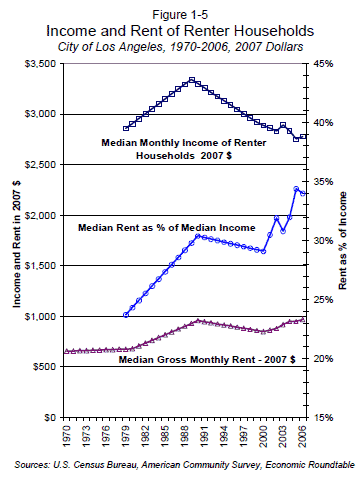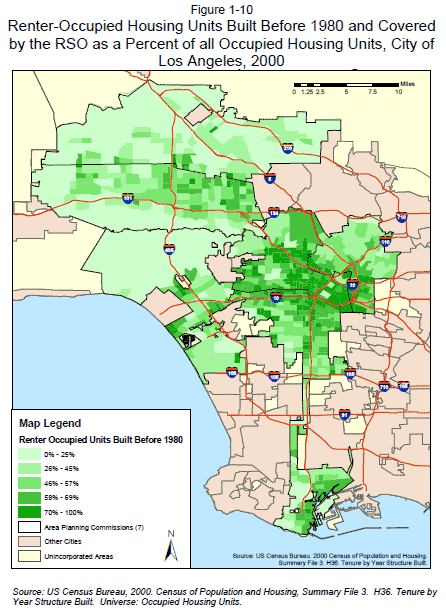Severe overcrowding in Los Angeles rental housing fell 63 percent from 2000 to 2007, the most recent year for which data is available. Only 9 percent of renters are severely overcrowded, with 1.5 or more occupants per room.
The bad news is that 58 percent of renters are rent-burdened, paying 30 percent or more of their income for rent. In addition, 31 percent are severely rent-burdened, paying over half of their income for rent.
In 2007, after LA’s housing bubble had burst, there were fewer rental units per person in the City, but because larger units were built, there were more bedrooms per person. However, these new units were often more expensive than the units they replaced.
The report was prepared for LA’s Housing Department to recommend how conditions in the housing market can be improved and how to fairly balance the interests of tenants and landlords under the City’s Rent Stabilization Ordinance. Two-thirds of the rental units in Los Angeles are regulated by the ordinance.
Surveys of 4,859 renters and 2,083 rental property owners found that a majority of both renters and owners agree that it is important to provide housing families can afford. Broadly supported solutions include building affordable units for families and seniors, subsidizing rental units to make them affordable, preserving existing affordable housing, home ownership programs for renters, and requiring new apartment buildings to have some affordable units.
Some of the findings shed new light on the impacts of rent control:
- Eight out of 10 apartments covered by LA’s rent control were purchased after enactment of this ordinance in 1978. Most owners have knowingly entered this market.
- Owners of rent-controlled buildings in Los Angeles enjoyed increases in value that were similar to buildings not covered by rent control.
- The rate of return on apartment investments is largely tied to when the investment was made. Most owners who purchased prior to about 2003, paid prices for their apartments that were reasonable relative to the current market value of their units.
- A third of renters surveyed either did not know or were wrong about whether their unit is under the Rent Stabilization Ordinance, and a majority did not know that the ordinance places limits on rent increases and reasons for eviction.
- Half of owners surveyed did not know that they can obtain additional revenue to pay for capital improvements to their buildings.
- Survey responses about rent increases showed that 30 percent of renters received smaller rent increases than could have been made under the Rent Stabilization Ordinance, but 27 percent of renters had rent increases that exceeded the allowable ceiling under the ordinance.
The report recommends creating a rent database for all rent-stabilized units to enable monitoring of rent increases and rent-banking. The concept of rent banking is that landlords would be able to defer authorized rent increases to a future year rather than having only the “use it or lose it” option in the current ordinance.
The findings and 28 recommendations for improvement will be presented to the City Council in fall 2009.
Background of the Study
“In 1979, the City of Los Angeles adopted the Rent Stabilization Ordinance (RSO) (Chapter XV of the Los Angeles Municipal Code) after finding that there was a shortage of decent, safe, and sanitary housing in the City resulting in a critically low vacancy factor. At that time, the City Council determined that it was necessary and reasonable to regulate rents so as to safe guard tenants from excessive rent increases while at the same time providing landlords with just and reasonable returns from their rental units. The City has not conducted a comprehensive assessment of the RSO since 1993. Due to market fluctuations, rising costs, and other economic factors of the last several years, apartment owners, tenants, and government officials alike have suggested that a new large scale review and economic study of the RSO in the context of the local housing market is necessary to determine if the RSO is still meeting its purpose and whether any amendments should be enacted.”
Press Coverage
Landlords say state rent caps may force them to raise rents more frequently
By Andrew Khouri, Los Angeles Times (October 7, 2019)
Landlords, Property Owners Scramble Ahead of California’s New Rent Control
BY Greg Cornfield, Commercial Observer (October 8, 2019)
LA Rent: Has rent control been successful in Los Angeles?
By Ben Berkman, 89.3 KPCC (September 12, 2014)
Data from the Study
The Economic Roundtable is making some of the project data from this study available to the public for free download. Please visit our Data Tools.
Related Articles
High Rent, Few Options: A Series of Stories on Renting in Los Angeles.
US Department of Housing and Urban Development. 2011. “The City of Los Angeles’ Rent Stabilization Ordinance Study” Breakthroughs. Volume 10, Issue 2: March 2011.
.















